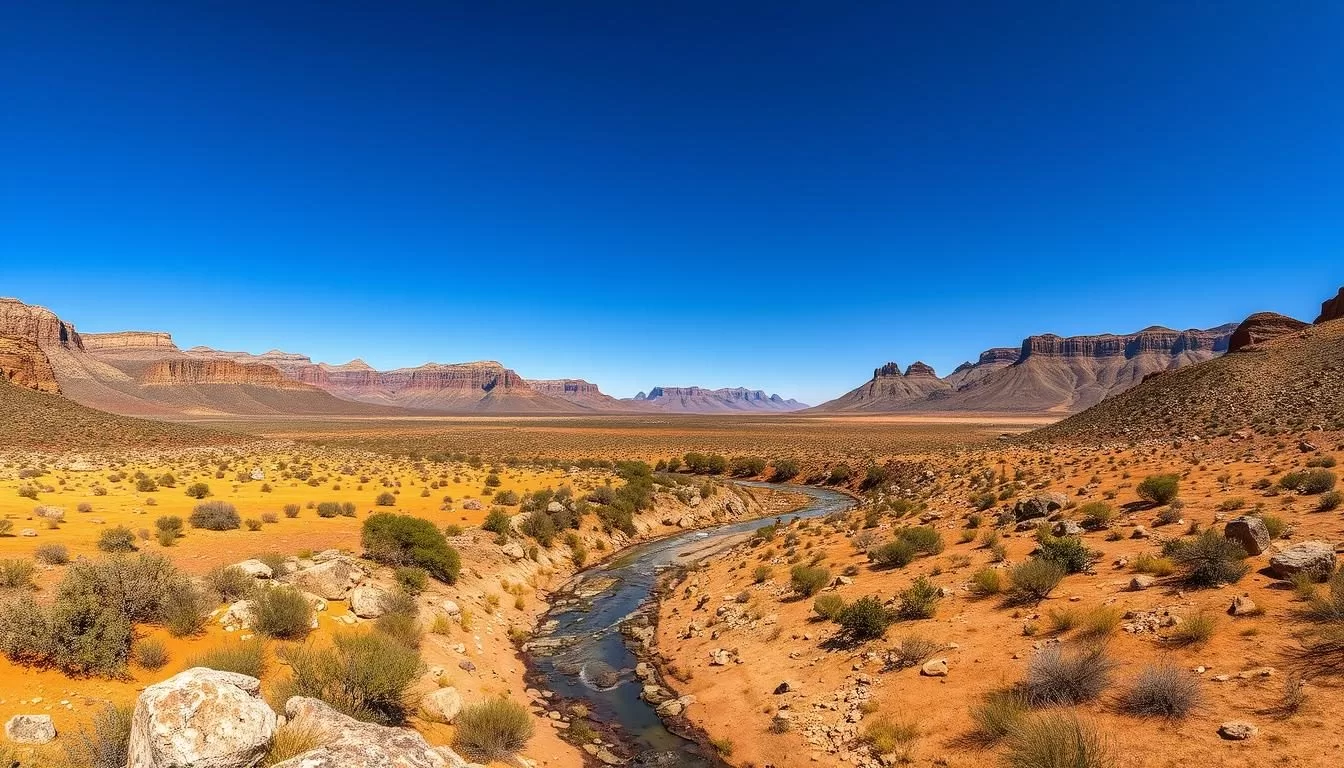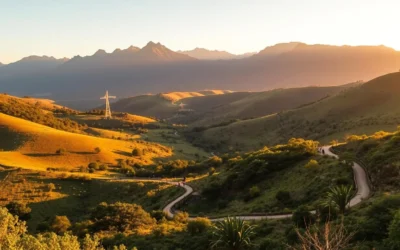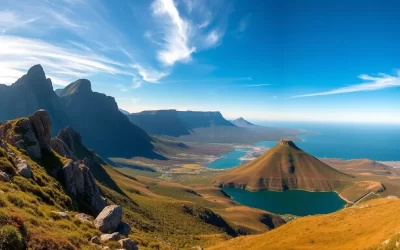Located on the northern stretch of South Africa’s remote west coast, this stunning national park offers a refreshing alternative to traditional safari experiences.
Imagine losing yourself in a majestic, arid landscape, where sweeping scrubland is interspersed by towering granite outcrops and hillsides studded with lonely quiver trees.
As you explore this incredible destination, you’ll discover a diverse range of flora and fauna, including an array of species that are adapted to the harsh desert environment.
With its unique landscapes and diverse wildlife, this park is a must-visit destination for nature lovers and adventure seekers alike, attracting a relatively small number of visitors each year.
Discovering Namaqua National Park
As you explore South Africa’s natural wonders, Namaqua National Park stands out as a unique destination. This park is a testament to the country’s rich biodiversity and conservation efforts.
Location and Geography
Namaqua National Park is located in the Northern Cape province of South Africa. The park’s diverse geography is characterized by its succulent ecosystems and a significant coastal section. Spanning over 141,000 hectares, it includes the area between the Groen and Spoeg rivers, making it a haven for a wide variety of flora and fauna.
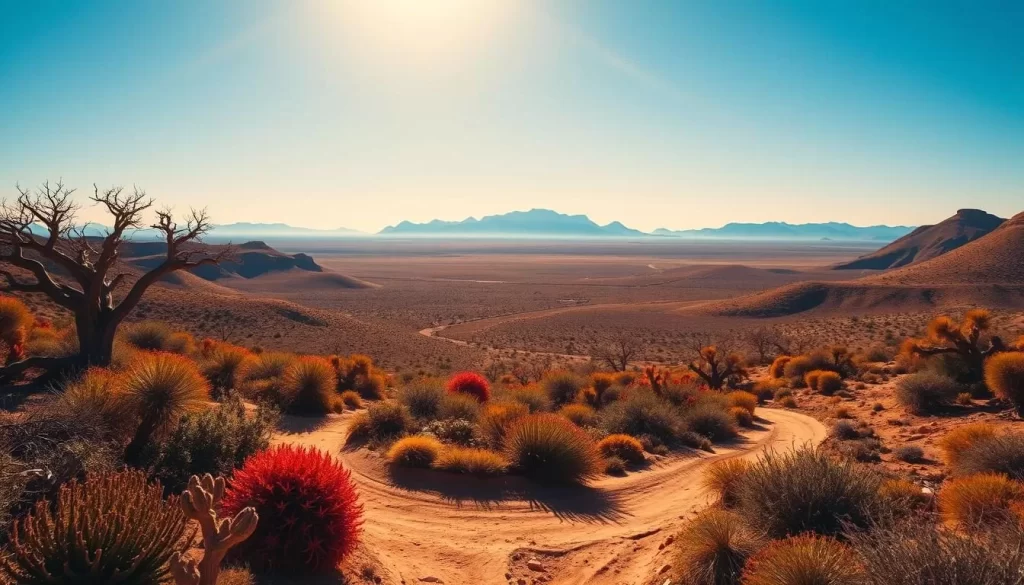
Park History and Conservation Efforts
The history of Namaqua National Park dates back to 1988 when the Skilpad Farm was purchased and established as a wildflower reserve. The park was officially inaugurated in 1999 and formally proclaimed a national park on June 29, 2002. The primary goal was to preserve the region’s extraordinary variety of succulent plants. Conservation efforts focus on protecting the estimated 3,500 plant species, with approximately 1,000 being endemic.
- The park has expanded significantly over the years to its current size, incorporating more ecosystems and a valuable coastal section.
- Initiatives like the Working for Water project, started in 2000, work to remove invasive plant species that threaten native flora.
- The park is not only a conservation success story for plants but also for the unique wildlife adapted to this harsh environment.
Your visit to Namaqua National Park contributes to ongoing conservation efforts, helping maintain this extraordinary ecosystem for future generations.
Experience the Spectacular Wildflower Superbloom
Experience the breathtaking beauty of Namaqua National Park during the wildflower season, a spectacle that attracts visitors from around the world. The park’s unique landscape transforms into a kaleidoscope of colors, creating a truly unforgettable experience.
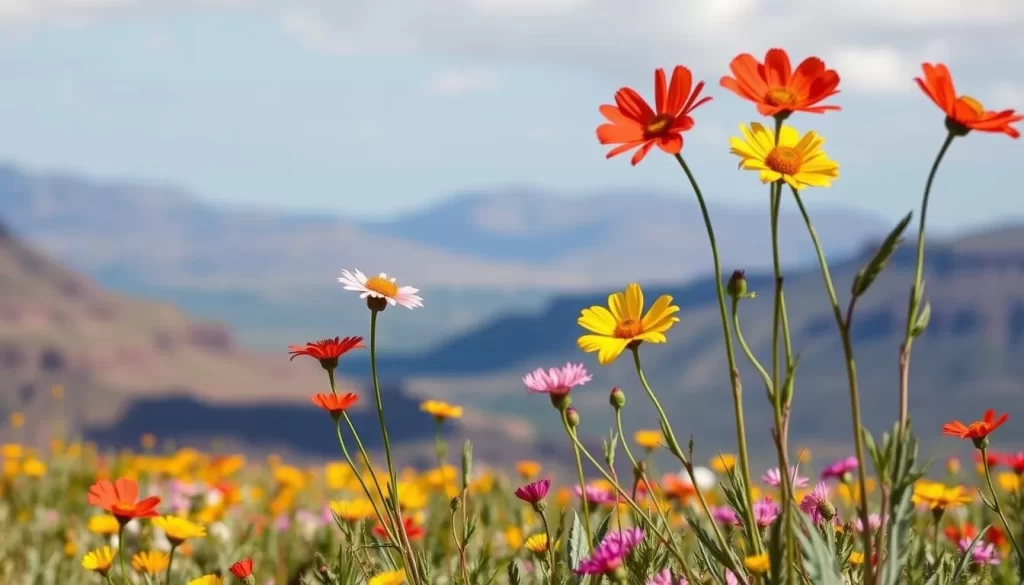
Best Time to Visit for Wildflowers
The best time to visit Namaqua National Park for wildflowers is during the spring and early summer months when the flowers are in full bloom. The exact timing depends on weather conditions, but generally, the park is at its most colorful from August to September.
This period offers the most spectacular display of wildflowers, with the park’s flat lands and hills covered in a blanket of colorful blooms.
Top Flower Viewing Spots
Some of the top spots to view the wildflowers include the flat lands where Hartebeests and Steenbok roam, and the areas around the sandy white beaches and small bays. The diverse scenery of the park offers numerous vantage points for taking in the breathtaking views.
The Skilpad area is particularly renowned for its vibrant displays of flower diversity.
Photography Tips for Capturing the Blooms
To capture the beauty of the wildflowers, consider the following photography tips:
- Take advantage of the golden hours of early morning and late afternoon for soft, magical light.
- Use a wide-angle lens to capture the vast carpets of flowers.
- Don’t forget a macro lens or close-up filters to capture the intricate details of individual flowers.
- Consider using a polarizing filter to enhance the vibrant colors of the wildflowers.
- Look for interesting foreground elements like rocks or wildlife to add depth to your photos.
Namaqua National Park, South Africa: Best Things to Do – Top Picks for Wildlife Enthusiasts
As you explore Namaqua National Park, you’ll discover a haven for wildlife enthusiasts. The park offers a diverse range of ecosystems that support a wide variety of wildlife, making it an ideal destination for those passionate about nature and conservation.
Unique Desert-Adapted Wildlife
The unique desert-adapted wildlife in Namaqua National Park is a major draw for visitors. The park is home to a variety of animals that have adapted to the harsh desert conditions, including Hartebeests and Steenbok. These animals roam freely across the flat lands, particularly during spring and summer when the area is blanketed with vibrant flowers.
The 21km Horizon Circle Route is a must-drive for anyone interested in seeing these desert-adapted creatures up close. As you drive through the coastal dunes and inland plains, you’ll have the opportunity to spot a range of wildlife in their natural habitat.
Bird Watching Opportunities
Bird watchers will be delighted by the variety of bird species found in Namaqua National Park, particularly in the coastal area. The park’s diverse ecosystems support a range of coastal bird species, including cormorants, gulls, and the African black oystercatcher. Visitors can enjoy spotting these birds along the shoreline and in the tidal pools.
- Keep an eye out for cormorants and gulls along the coast.
- The African black oystercatcher is a rare sighting that bird enthusiasts will cherish.
Marine Life Along the Coastal Section
The coastal section of Namaqua National Park, stretching from the Groen River mouth northward, offers a unique ecosystem teeming with marine life. Visitors can enjoy watching Heaviside’s dolphins playing in the waves of the small bays and spotting migrating humpback whales during the right season (June to November).
Marine enthusiasts will also appreciate the numerous tidal pools along the shoreline, which are home to a fascinating array of smaller marine creatures, including colorful anemones, starfish, and small fish.
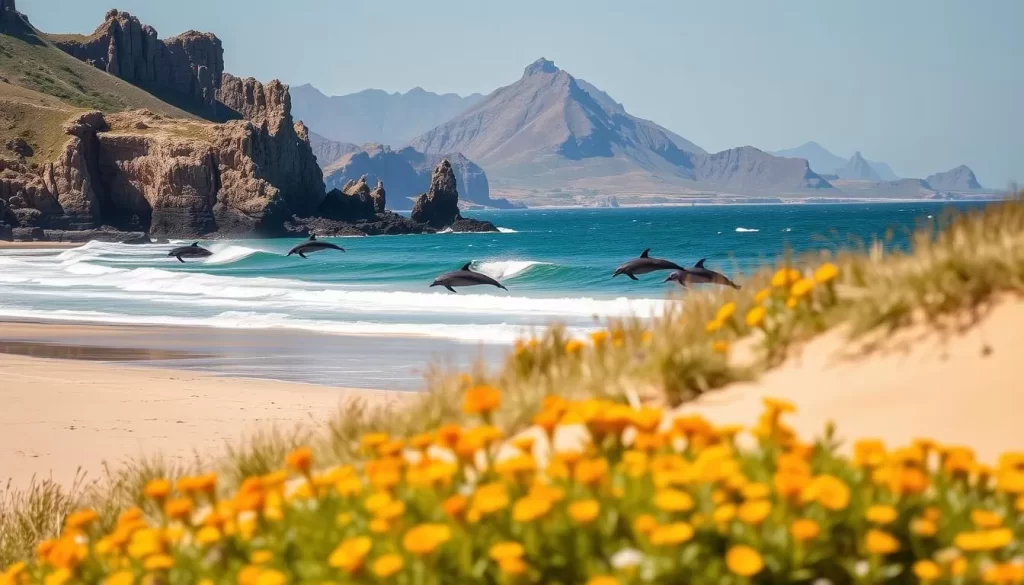
Explore the Park’s Scenic Hiking Trails
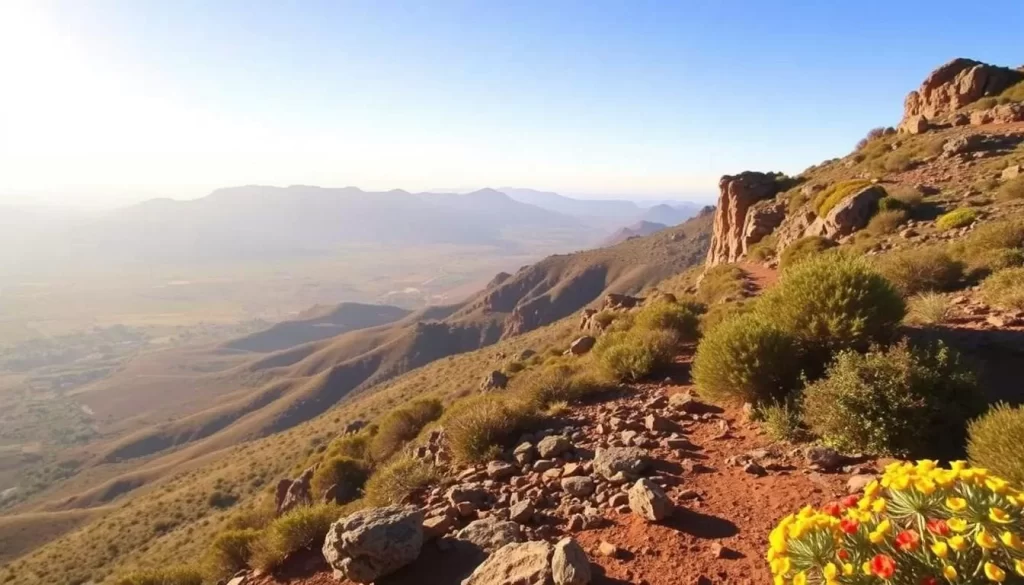
Explore the natural splendor of Namaqua National Park through its extensive network of hiking trails, designed to showcase the park’s unique flora and fauna. The park offers a range of trails that cater to different skill levels, ensuring that every visitor can experience the beauty of this unique ecosystem.
Skilpad Walking Trail
The Skilpad Walking Trail is a must-visit for anyone looking to immerse themselves in the park’s renowned wildflowers. This trail is relatively easy, making it accessible to visitors of all ages and fitness levels. As you walk, you’ll be surrounded by a kaleidoscope of colors, especially during the wildflower season.
Korhaan Walking Trail
The Korhaan Walking Trail offers a slightly more challenging hike, taking you through varied landscapes that showcase the park’s diverse geology and flora. This trail is perfect for those looking to explore beyond the wildflowers and get a deeper understanding of the park’s ecosystem.
Heaviside Hiking Trail
For the more adventurous, the Heaviside Hiking Trail provides a longer, more challenging hike that rewards visitors with breathtaking views of the surrounding landscape. This trail is ideal for those looking to spend a full day exploring the park’s natural beauty.
Mountain Biking Options
Mountain bikers are also welcome to explore any of the roads or tracks that are open to the public, but must bring all of their own equipment with them. You’ll be pleased to know that Namaqua National Park welcomes mountain bikers on all public roads and tracks, offering a different way to experience the park’s vast landscapes.
- Unlike some national parks with designated biking trails, Namaqua allows you to create your own adventure by following the network of accessible roads throughout the park.
- Remember that you must bring all your own equipment as there are no rental facilities within the park—come prepared with a well-maintained bike, spare parts, and plenty of water.
- The terrain varies from relatively flat gravel roads in the Skilpad area to more challenging sandy and rocky tracks in other sections of the park, catering to different skill levels.
Driving Routes and 4×4 Adventures

Get ready to explore one of South Africa’s most stunning national parks through its varied driving routes and challenging 4×4 trails. Namaqua National Park offers a unique driving experience, with roads and tracks that cater to different types of vehicles and driving skills.
The Caracal Eco Route
The Caracal Eco Route is one of the park’s most popular 4×4 trails, offering a thrilling adventure through diverse landscapes. This route is approximately 160 km long and is designed to showcase the park’s unique geology, flora, and fauna. The trail can take around 6-8 hours to complete, depending on how many stops you make along the way.
Key Highlights: Scenic viewpoints, diverse wildlife, unique rock formations.
Coastal Section Driving
For those with a 4×4 vehicle, the coastal section of Namaqua National Park offers breathtaking views of the Atlantic Ocean and the opportunity to explore remote beaches and coves. The rugged terrain requires a vehicle with good ground clearance, and drivers should be prepared for challenging conditions.
Be sure to check the weather and track conditions before heading out.
Vehicle Requirements and Tips
While a standard sedan or 2WD vehicle can access the Skilpad section of the park, a 4×4 vehicle is necessary for exploring the off-road tracks and coastal section. Ensure your vehicle is in good condition, with a full tank of fuel, and carry basic spares and tools. Be mindful of the weather, especially during the winter months (June to August), when tracks can become slippery or muddy.
Tips: Avoid driving during the hottest part of the day, carry extra water, and inform park staff of your planned route and expected return time.
Conclusion: Planning Your Visit to Namaqua National Park
Whether you’re a seasoned traveler or just starting to plan your South African adventure, Namaqua National Park is a gem worth exploring. Located near Kamieskroon, which is accessible via the N7 highway, the park is about 5 hours north of Cape Town or 45 minutes south of Springbok.
To experience the park at its best, time your visit according to your interests. For the spectacular wildflower bloom, plan your trip for August to September. If you prefer a more solitary experience, consider the quieter winter months from June to August.
Accommodation within the park is limited and tends to book up quickly, especially during wildflower season, sometimes a year in advance. The park offers various options, including chalets at Skilpad Rest Camp, Luiperdskloof Guest Cottage, coastal campsites, and the luxury Namaqua Flower Camps during bloom season.
Before heading to Namaqua National Park, remember that it’s a wilderness destination with no amenities. The park gates are open from 8 a.m. to 5 p.m. daily, and a conservation fee is required (currently R96 per adult and R48 per child). Come prepared with all necessary supplies, as the nearest gas stations and ATMs are in Springbok.
Visiting Namaqua National Park in South Africa offers a unique opportunity to experience one of the world’s most remarkable floral kingdoms. Whether you’re drawn to the wildflowers, desert-adapted wildlife, or the pristine coastal section, the park provides an authentic wilderness experience that will leave you with lasting memories of South Africa’s natural heritage.
The above is subject to change.
Check back often to TRAVEL.COM for the latest travel tips and deals.
